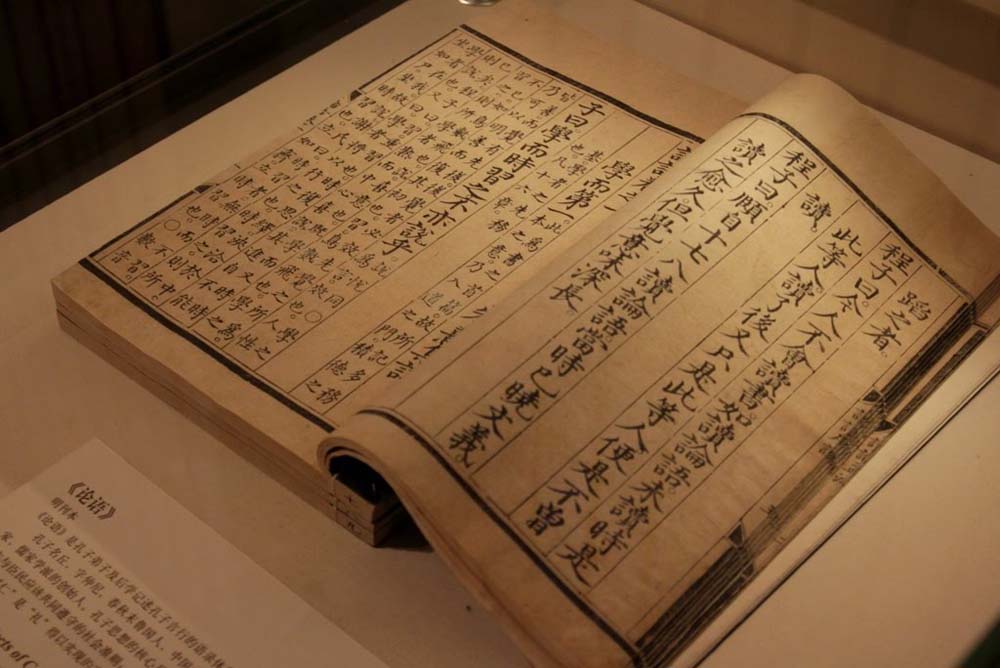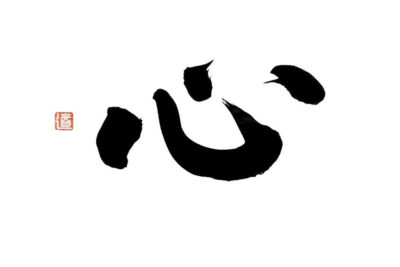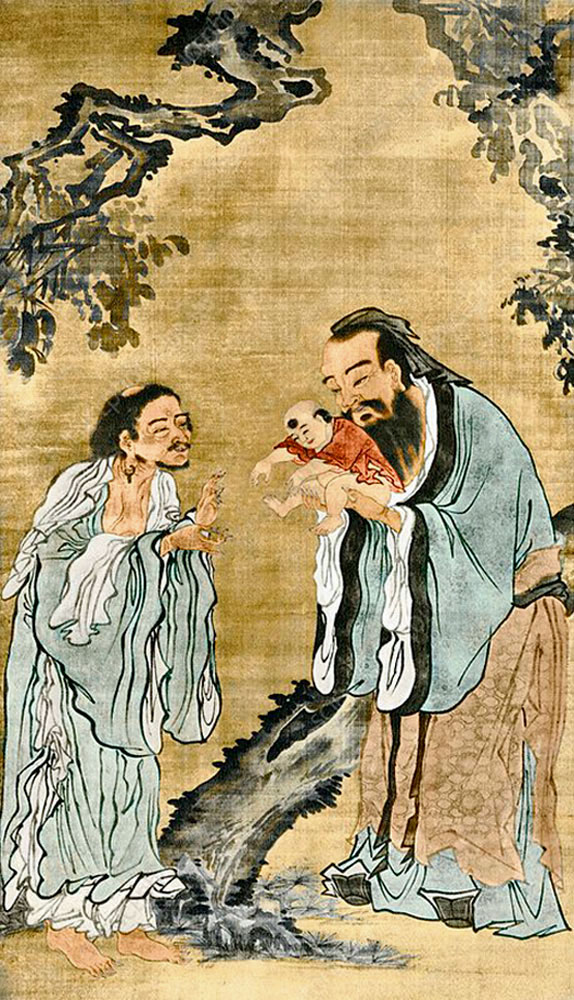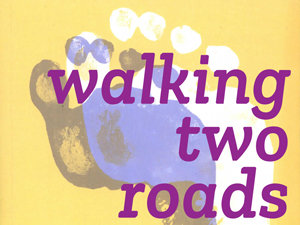Hans van Rappard
4 ― From: Rappard, H. van (2009). Walking Two Roads ― Accord and Separation In Chinese and Western Thought. Amsterdam: VU University Press. Chapter 2, pp. 51-54.
part 1 – part 2 – part 3 – part 4 – part 5 – part 6 – part 7 – part 8 – part 9 – part 10 – part 11 – part 12 – part 13 – part 14 – part 15 – part 16 – part 17
No ‘psychology’ in ancient China

Given its persistence over some twenty five centuries and the number of people whose lives have been shaped, and are again being shaped by it[2]. Confucianism is arguably the most influential philosophy that the world has seen. In Book XV, 30 of the Lunyu Confucius is recorded as having said,
“I once spent a whole day without food and a whole night without sleep, in order to meditate. It was of no use. It is better to learn.”
In a note to this saying, translator Waley observes that the word meditate did not refer to some kind of yogic practice but to thinking. However, the meaning of the verb is vastly different than our notion of it. Significantly, in the Chinese understanding there is not the slightest indication of the Western concept of thinking as an “interior process of cogitation” because it views thinking as continuous with perception.
Thinking should therefore be understood as a
“fixing of the attention (located in the middle of the belly) on an impression recently imbibed from without and destined to be immediately re-exteriorized in action.”[3]
The Chinese concept of xin
The topic of this chapter is the Chinese concept of xin. The word used to be translated as ‘mind’ but nowadays xin is increasingly rendered as ‘heart-mind’ and for reasons that will become clear in the following this will also be done here.
In view of its topic, along with Waley’s comment on the Confucian saying above, one might be forgiven for thinking that this paper is about ancient Chinese psychology.
But it is not, and there are several reasons for this. One reason is that the Chinese concept of the heart-mind covers a domain that is in significant respects incongruent with the field worked by scientific psychology. The contemporary psychological science studies human behaviour, including mental behaviour. It conducts research on, say, perception or cognition, and the underlying processes in the brain, helps select personnel, treats neuroses, studies the human life cycle and group behaviour, and has even managed to sneak into neighbouring fields such as linguistics and economics.
The interests of modern psychologists are virtually unlimited, but ― using a term whose ramifications will be unpacked below ― all have to do with the world of the ‘ego’. Even when they are working in the secluded world of the laboratory, ultimately psychologists are dealing with behaviour in the everyday world of trying to get ahead in life, to get a job or a grade, to become happy or at least less unhappy, and so on.
Although the odd therapist or researcher may stray into the reaches of the human mind beyond the ego most colleagues fear to tread into these worlds, if only because the hall-marks of science, measurement and quantification cannot be applied there. Moreover, while modern science is emphatically not interested in the moral aspects of its subject matter, when dealing with the heart-mind these cannot be avoided.

These arguments will not convince everyone. Some may still want to insist that concepts like the heart-mind must perforce pertain to psychology. If not scientific psychology then to Freudian or Jungian ‘depth psychology’ or in any case to what is called philosophical psychology or philosophy of mind. After all, one might say, the word psychology dates from long before its emergence as a science and has been used since at least the eighteenth century and according to some already in ancient Greek philosophy.
Some kind of psychology, it might be contended, has been around for a long time. But this historical argument goes only so far. Although some sort of psychology has indeed been with us for a good amount of time, calling these early forms ‘psychology’ would entail that, given its modern usage, the term has to be stretched to the breaking point.
No psychology in Chinese thought
But this discussion should not be allowed to carry us away for the simple reason that it is superfluous. This is so because the reader who would embark on the study of Chinese thought with hopes of finding some kind of psychology ― be it philosophical, deep, or just pre-scientific ― is in for a deception: there is no psychology to be found in the traditional Chinese way of thinking.
True enough, writing on the Chinese world of thought, Forke spent a chapter on ‘psychology’, discussing subjects like the soul, desires and passions, and immortality. But even in the relatively philosophical psychology of Germany in the 1920s such topics were no longer studied. What is more, Forke began the chapter with the observation that the views of the Chinese resembled the ‘naive ideas’ of the Greek and Indians, even if they were ‘lagging behind’. And this was putting it mildly. As Forke himself acknowledged, there is nothing like Aristotle’s De Anima to be found in the Chinese literature, nor anything like the Indian Upanishads or the writings of the Samkhya.[5]
Now, quite apart from the question if these writings deserve to be called psychology, the point is that even if one is prepared to stretch the meaning of the word as far as Forke did almost a century ago, there is still no psychology to be found in the Chinese world of thought.
A brief look at Waley’s comment is sufficient to realise that to the extent that Confucius can be taken as a representative sample, the Chinese were not particularly well equipped to develop ‘psychological’ notions. Clearly, the faculty of thinking as it emerges from Waley offers little scope for a subjective world, while Benjamin Schwartz when writing on the Analects studiously avoids the words psychology and psychic states.[6] Nor were they applicable to other classical thinkers.
Hajime Nakamura, studying the way of thinking of Eastern peoples concluded that the Chinese, in contradistinction to the Indians, had not developed anything resembling a science of the mind.[7]
More recently, Chad Hansen built an entire theory of Chinese thought on a similar view, arguing that the Chinese didn’t ever postulate an inner mental life featuring subjective experience or consciousness. Hansen concluded ― and this sits quite well with Waley’s comment ― that the idea of a person,
“as someone with a faculty of reason, who can process inner sentences … belongs to the Indo-European philosophical traditions.”[8]
Historians of psychology arrived at the same conclusion.[9] Thus it would seem that we are not likely to find in Chinese thought much that might teach us about the heart-mind and related concepts like consciousness and ego. But this presents us with a serious difficulty because it is precisely at this point that important differences are found between the Chinese and Western ways of thinking.
Importance of the Buddhist view

There is, I think, a way out of this problem ― albeit a curiously roundabout way. What I propose is to try and unpack some of the significant features of heart-mind and consciousness by way of Buddhism. This must seem preposterous. How could an Indian religion teach anything about the Chinese concept of xin, whereas we have just learned that the Indian and Chinese ways of thinking were very different from each other?
Curiously however, while there are huge differences between the two countries the Indian religion of Buddhism managed to adapt very well to its foreign Chinese surroundings. What is more, once established, Buddhism proved so influential that it became one of the three main currents of Chinese philosophy, next to Confucianism and Daoism.
From an early date in its development it has been in close touch which Daoism, which contributed heavily to its transformation from Buddhism in China to Chinese Buddhism. It is especially Zhuangzi who has been important in this respect. Moreover, in the course of time Daoism and Buddhism became so close to each other that to the average Chinese they amounted to the same. But admittedly, the relation of Buddhism to Confucianism has not been quite so straightforward.
During the Chinese Middle Ages (roughly 200-900) Confucianism went into decline while Daoism, and in its wake Buddhism too flourished. During the Song dynasty (960-1278) however, it was re-animated and began to react to Buddhism, presenting itself as the authentic Chinese school.
But the resulting Neo-Confucianism was nevertheless much influenced by Buddhism and during the subsequent dynasties the two movements got close enough to allow people to smoothly practice both at the same time.
What may be inferred from the above is the following. Considering that the Chinese philosophical schools did not advance explicit views on heart-mind and consciousness whereas Buddhism did, and also that in spite of its Indian origins the latter could become an intimate part of the intellectual make-up of the Chinese[11], it would seem feasible to use the Buddhist view to articulate to some extent the implicit Chinese notions.
The Norwegian missionary Karl Reichelt, working in China in the early years of the last century had ample opportunity to get to know
“the profound impression made by Buddhism upon the soul of the Chinese people. Deep, deep have the lines been chiselled … If one wishes to understand China, one must see it in the light of Buddhism.”[12]
- Bell, D.A. (2008). China’s new Confucianism. Princeton: Princeton U.P.
- Blowers, G., Cheung, B.T. & Ru, (2009). Emulation vs. indigenization in the reception of western psychology in Republican China: An analysis of the content of Chinese psychology journals (1922- 1937)-Journal of the History of the Behavioral Sciences, XLV, 21-33.
- Bourke, V.J. (1964). Will in Western thought. New York: Sheed and Ward
- Chan, Wing-tsit. (1963). A sourcebook in Chinese philosophy. Princeton: Princeton U.P.
- Ch’en, K.K.S. (1964). Buddhism in China. Princeton: Princeton U.P.
- Conze, E. (Transl.). (1988). Buddhist wisdom books: Containing the Diamond sutra and the Heart sutra. London: Unwin.
- Forke, A. (1927). Die Gedankenwelt des Chinesischen Kulturkreises. München: Oldenbourg.
- Haldane, E.S. & Ross, G.R.T. (Transls.). (1973). The philosophical works of Descartes, I. Cambridge: Cambridge U.P.
- Hansen, C. (2000). A Daoist theory of Chinese thought. New York: Oxford U.P.
- Hume, D. (1739-40/1996). Treatise of human nature. Thoemmes Press.
- Krailsheimer, A. J. (Transl). (1995). Blaise Pascal: Pensees (1670). London: Penguin Books.
- Merton, Th. (1948/1975). The seven storey mountain. London: Sheldon Press.
- Nakamura, H. (i960). The ways of thinking of Eastern peoples. Tokyo: Printing Bureau, Japanese Government.
- Reichelt, K.L. (1928/2001). Truth and tradition in Chinese Buddhism. New Delhi: Munshiram Manoharlal Publ.
- Schwartz, B.I. (1985). The world of thought in ancient China. Cambridge (MA): Harvard U.P.
- Trevor, M.H. (Transl.).(1969). The ox and its herdsman. Tokyo: The Hokuseido Press.
- Waley, (Transl.). (1992). The Analects of Confucius. New York: HarperCollins.
- Wallace, B.A. & Shapiro, S.L. (2006). Mental balance and well-being: Building bridges between Buddhism and Western psychology. American Psychologist, 61, 690-701.
- Watson, (Transl.). (1968). The complete works of Chuang Tzu. New York: Columbia U.P.
- Watson, (Transl.). (2003). Zhuangzi — Basic writings. New York: Columbia U.P.
Notes
[1] Source: Lun Yu (Analects)
[2] Bell, 2008
[3] Waley, 1992, pp. 44-45
[4] Source: heart-mind-chinese-calligraphy
[5] Forke, 1927
[6] Schwartz, 1985, p. 75
[7] Nakamura, 1960
[8] Hansen, 2000, p. 53
[9] Blowers et al., 2009
[10] Source: Confucius handing over Gautama Buddha to Laozi
[11] Ch’en, 1964, p. 471
[12] Reichelt, 2001, p. 311



